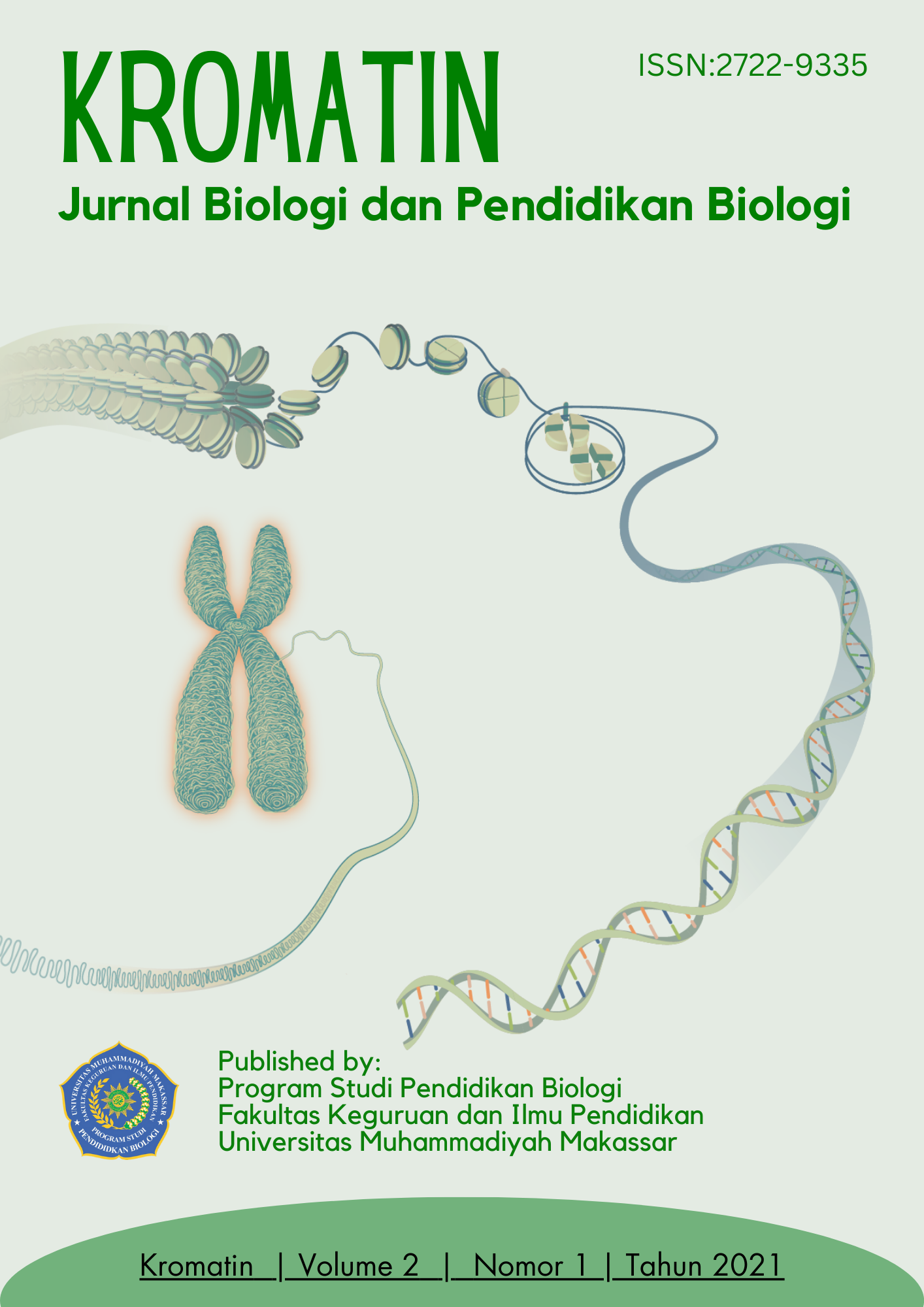Penerapan Strategi Predict Observe Explain (POE) untuk Meningkatkan Hasil Belajar Siswa di Kelas VII SMP Ittihad Makassar
Abstract
This research is a classroom action research (Classroom Action Research) which aims to improve student learning outcomes through the application of the Predict-Observe-Explain (POE) strategy on the subject of classification of living things that can improve student learning outcomes. The subjects of this study were seventh grade students of Madani Makassar Middle School in the odd/even semester of 2021 with a total of 20 students. This research was carried out in two cycles, in the first cycle there were 4 meetings including the end of the cycle text, as well as in the second cycle. Data collection techniques were carried out with observation sheets and learning outcomes tests. The results of the research that were achieved after implementing the action by applying the Predict Observe Explain (POE) strategy using the Guided Teaching Method in class VII SMP Ittihas Makassar was an increase in science learning outcomes, which was 76.99% in the first cycle and became 82.75% in the first cycle. cycle II. Keywords: Predict observe explain, learning outcomesReferences
Arikunto, S. (2013). Prosedur Penelitian: suatu pendekatan praktik (R.Cipta (ed.)).
Basuki, K. (2019). Melatihkan Keterampilan Berpikir Kritis Peserta Didik Melalui Strategi Predict Observe Explain (Poe) Pada Materi Kesetimbangan Kimia Kelas Xi Sman 11 Surabaya Training. Issn 2502-3632 (Online) ISSN 2356-0304 (Paper) Jurnal Online Internasional & Nasional Vol. 7 No.1, Januari – Juni 2019 Universitas 17 Agustus 1945 Jakarta, 53(9), 1689–1699. www.journal.uta45jakarta.ac.id
Budiwibowo, S. (2016). Hubungan Minat Belajar Siswa Dengan Hasil Belajar Ips Di Smp Negeri 14 Kota Madiun. Gulawentah:Jurnal Studi Sosial, 1(1), 60. https://doi.org/10.25273/gulawentah.v1i1.66
Eriza Nur Hidayanti, D. (2016). Penerapan Metode Edutainment Humanizing The Classroom Dalam Bentuk Moving Class Terhadap Hasil Belajar. Jurnal Pendidikan Ilmu Sosial, 26(1), 11–26.
Fahri, M. B. P. (2014). Penerapan Model Problem Based Learning (PBL) Untuk Meningkatkan Hasil Belajar Siswa Pada Materi Panjang Garis Singgung Persekutuan Dua Lingkaran di Kelas VIII SMP Negeri 19 Palu. Jurnal Elektronik Pendidikan Matematika Tadulako, 2(1), 67–77.http://jurnal.untad.ac.id/jurnal/index.php/JEPMT/article/view/3232
Fandra Amarullah. (2016). Penerapan Model Pembelajaran Guided Teaching Berbasis Media Visual Untuk Meningkatkan Hasil Belajar Siswakelas Vii Pada Mata Pelajaran Ips Terpadu Di Smp Negeri 1 Darussalam Aceh Besar. Angewandte Chemie International Edition, 6(11), 951–952.
Guguh Gumilar. (2015). Pengaruh Model Pembelajaran Aktif Guided Teaching Terhadap Hasil Belajar Siswa Pada Standar Kompetensi Merekam Audio Distudio Dismkn 2 Surabaya. Jurnal Pendidikan Teknik Elektro, 4(2), 633–638.
Hisbiyati, H., & Khusnah, L. (2017). Penerapan Media E-Book Berekstensi Epub Untuk Meningkatkan Minat Dan Hasil Belajar Siswa Smp Pada Mata Pelajaran Ipa. Jurnal Pena Sains, 4(1), 16. https://doi.org/10.21107/jps.v4i1.2775
Iswatun, I., Mosik, M., & Subali, B. (2017). Penerapan model pembelajaran inkuiri terbimbing untuk meningkatkan KPS dan hasil belajar siswa SMP kelas VIII. Jurnal Inovasi Pendidikan IPA, 3(2), 150. https://doi.org/10.21831/jipi.v3i2.14871
Jamaludin, D. N. (2018). Penggunaan Guided Teaching Dalam Mengorganisasikan Konsep Pada Pembelajaran Sistem Peredaran Darah. Journal Of Biology Education, 1(2), 121. https://doi.org/10.21043/jobe.v1i2.4109.
Kusuma, A. C., & Afriliana, I. (2018). Efektifitas Pembelajaran Guided Teaching dengan E-Learning untuk Meningkatkan Kemampuan Komunikasi Matematik Mahasiswa. Desimal: Jurnal Matematika, 1(3), 315–327. https://doi.org/10.24042/djm.v1i3.2962
Rasydah Nur Tuada, Gunawan, S. (2013). Pengaruh Model Pembelajaran Generatif Dengan Teknik Guided Teaching Terhadap Keterampilan Proses Sains. Journal Of Chemical Information And Modeling, 53(9), 1689–1699.
Septian, D. (2019). Pengaruh Multimedia Interaktif Berbasis Learning Cycle Terhadap Hasil Belajar Siswa. JPFS Jurnal Pendidikan Fisika Dan Sains, 2(1), 6–16.
Sugiyono. (2010). Metode Penelitian Bisnis (Pendekatan Kuantitatif, Kualitatif, dan R&D (Alfabeta (ed.)).
Suyanto, Y. P., Susanto, H., & Linuwih, S. (2012). Keefektifan Penggunaan Strategi Predict, Observe and Explain Untuk Meningkatkan Kemampuan Berpikir Kritis Dan Kreatif Siswa. Unnes Physics Education Journal, 1(1). https://doi.org/10.15294/upej.v1i1.765
Downloads
Published
Issue
Section
License
Authors who publish with this journal agree to the following terms:
1. Authors retain copyright and grant the journal right of first publication with the work simultaneously licensed under a Creative Commons Attribution 4.0 Internasional License that allows others to share the work with an acknowledgement of the work's authorship and initial publication in this journal.
2. Authors are able to enter into separate, additional contractual arrangements for the non-exclusive distribution of the journal's published version of the work (e.g., post it to an institutional repository or publish it in a book), with an acknowledgement of its initial publication in this journal.
3. Authors are permitted and encouraged to post their work online (e.g., in institutional repositories or on their website) prior to and during the submission process, as it can lead to productive exchanges, as well as earlier and greater citation of published work.
Licence:
Authors are free to:
1. Share: Copy and redistribute the material in any medium or format
2. Adapt: Remix, transform, and build upon the material for any purpose, even commercially.
The licensor cannot revoke these freedoms as long as the authors follow the license terms, which include the following:
1. Attribution: Authors must give appropriate credit, provide a link to the license, and indicate if changes were made. Authors may do so in any reasonable manner, but not in any way that suggests the licensor endorses the authors or authors’ use.
2. No additional restrictions: Authors may not apply legal terms or technological measures that legally restrict others from doing anything the license permits.
This work is licensed under a licensed under a Creative Commons Attribution 4.0 Internasional License/ CC BY 4.0.


